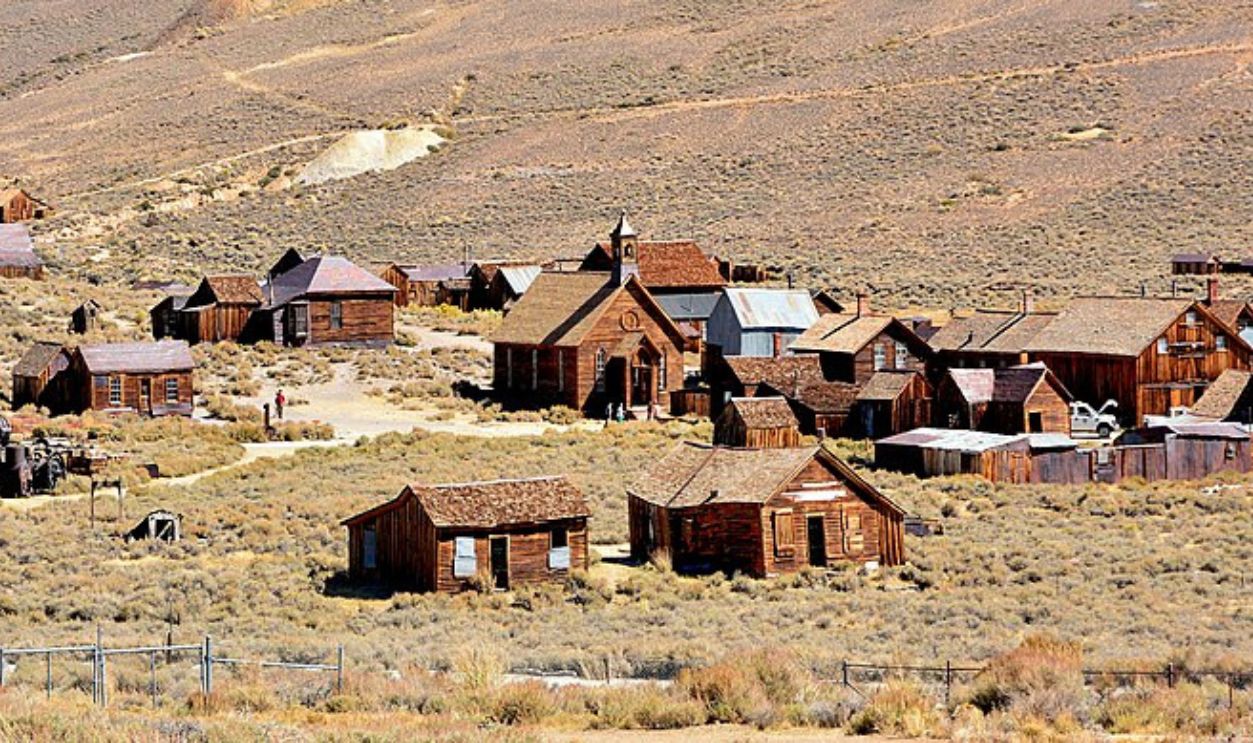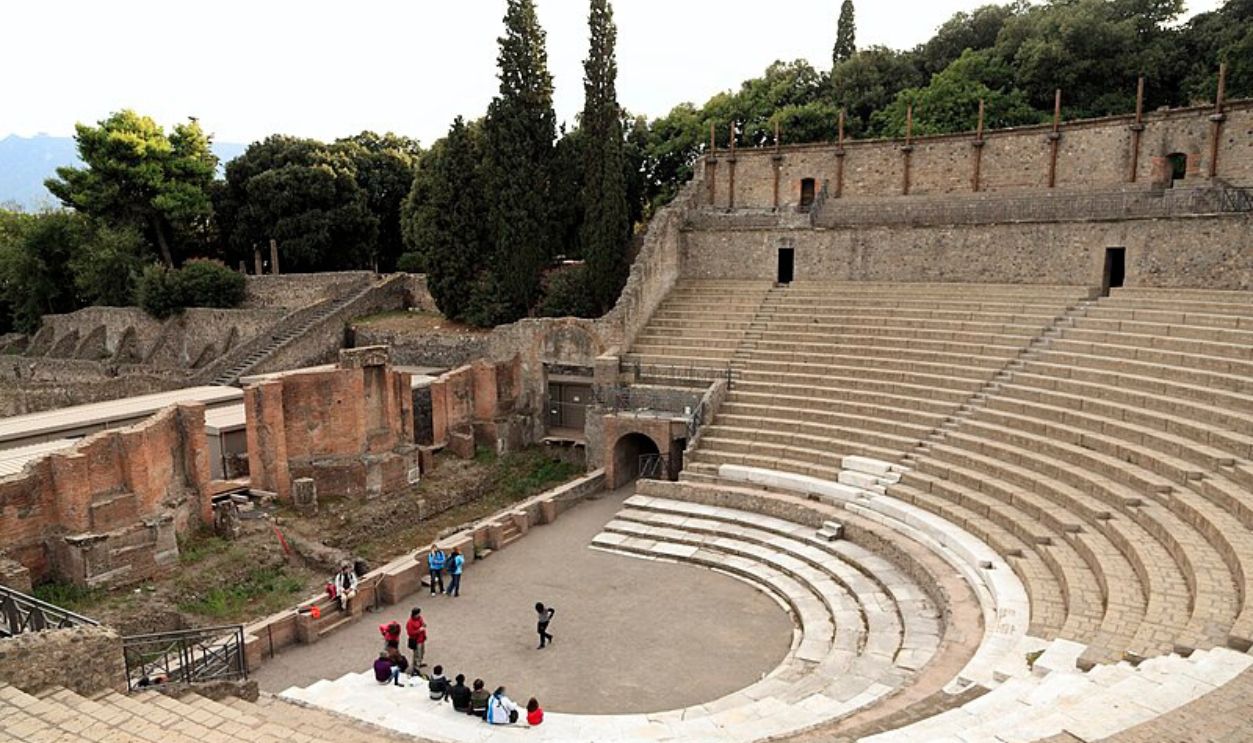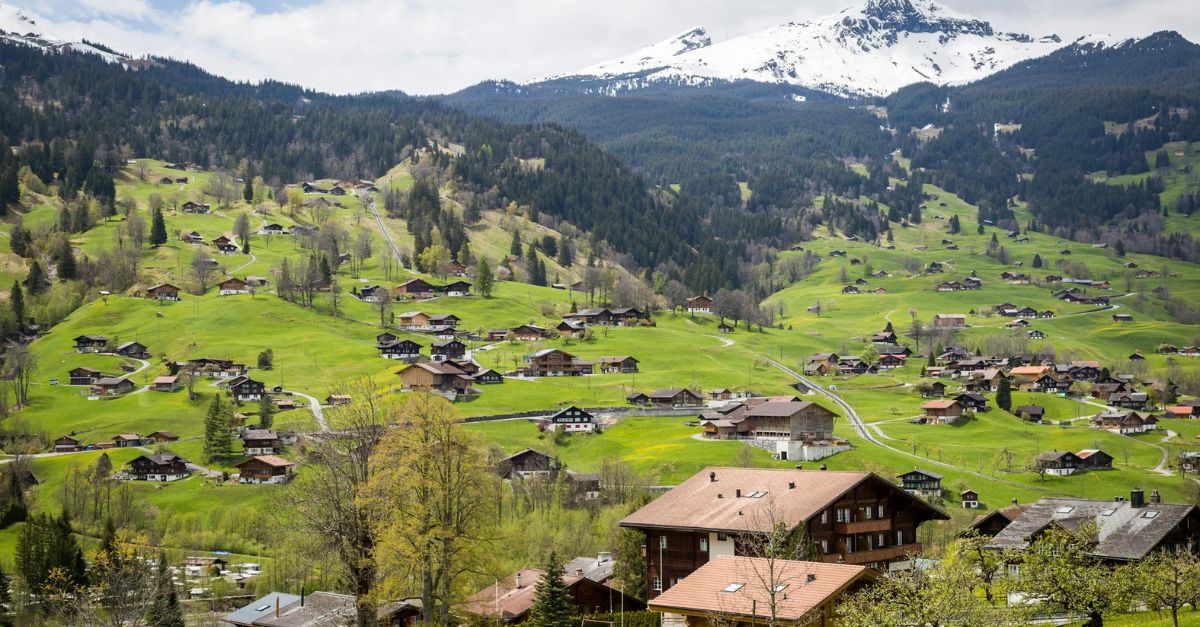Nature’s Wrath
Nature’s power to take back abandoned spaces is humbling, to say the least. Sunken cities and overgrown ruins reveal how the wild reshapes what humans leave behind and how, in the fight between Man vs. Nature, nature always triumphs. These are 43 of those instances.

Germany’s Abandoned Amusement Park
Spreepark opened in 1969 as East Germany’s premier amusement park. After its closure in 2002, nature began overtaking its structures. However, renovations are in progress which aim to change the park into a cultural hub by 2026.
 Nadia Nadienka, CC BY-SA 4.0, Wikimedia Commons
Nadia Nadienka, CC BY-SA 4.0, Wikimedia Commons
Parícutin Lava Church
In 1943, Parícutin erupted in a Michoacán cornfield, rapidly engulfing the nearby village of San Juan Parangaricutiro. The church was partly spared by the lava. The volcano, now dormant, is a geological marvel visited by hikers and scientists.
SS Ayrfield Shipwreck
The SS Ayrfield, a WWII-era ship, was abandoned in Homebush Bay in the 1970s. Over time, mangroves took root within its hull, turning the rusting vessel into a lush, floating sanctuary. The ship is now a beloved ecological landmark in Sydney.
Ballybeg Priory
Dating back to the 13th century, Ballybeg Priory in Ireland served as a medieval monastery. Following its abandonment during the Dissolution of the Monasteries, the site gradually succumbed to nature. Thick ivy now cloaks the ancient stonework.
Houtouwan Fishing Village
Once home to over 2,000 residents, the fishing village of Houtouwan was abandoned in the 1990s due to economic decline and limited resources. Since then, thick ivy and vegetation have swallowed the buildings, but it still attracts visitors.
 Milkomède, CC BY-SA 4.0, Wikimedia Commons
Milkomède, CC BY-SA 4.0, Wikimedia Commons
Beng Mealea Temple
Beng Mealea was constructed during the 12th century under King Suryavarman II and was abandoned as the Khmer Empire declined. Encased in a dense jungle, its intricate carvings and sandstone blocks are entwined with massive roots.
 Gary Todd, CC0, Wikimedia Commons
Gary Todd, CC0, Wikimedia Commons
Packard Factory Overgrowth
Once a symbol of automotive innovation, Detroit's Packard Plant ceased operations in 1958 as the industry declined. The factory is now overtaken by greenery and wildlife. Efforts to repurpose the site continue, but much of it remains a relic of urban abandonment.
 Albert duce, CC BY-SA 3.0, Wikimedia Commons
Albert duce, CC BY-SA 3.0, Wikimedia Commons
Lake Kaindy Forest
A 1911 earthquake caused a landslide, which led to Lake Kaindy (in Kazakhstan, by the way) submerging a forest of spruce trees. Today, their ghostly trunks rise above the turquoise water in an eerie and insanely beautiful way.
 Inverseharpy, CC BY-SA 4.0, Wikimedia Commons
Inverseharpy, CC BY-SA 4.0, Wikimedia Commons
Kolmanskop Village
In Kolmanskop, Namibia, shifting sands have buried the village’s remnants. Once alive with diamond miners, it has been overtaken since the 1950s. Now, a surreal desertscape remains, which shows nature’s quiet persistence.
 SkyPixels, CC BY-SA 4.0, Wikimedia Commons
SkyPixels, CC BY-SA 4.0, Wikimedia Commons
City Methodist Church
Gary’s City Methodist Church was built in 1925 and closed in 1975 due to urban decline. Decades of neglect allowed ivy to overrun the walls and wildflowers to grow in its sanctuary. Photographers keep coming to capture its haunting beauty.
 Peter Fitzgerald, CC BY 3.0, Wikimedia Commons
Peter Fitzgerald, CC BY 3.0, Wikimedia Commons
Cockatoo Island Mangroves
Once a hub for shipbuilding and industry, Sydney’s Cockatoo Island has been reclaimed by nature. Mangroves now thrive among rusting docks and crumbling structures, creating a peaceful refuge for wildlife and visitors.
 spud murphy from Sydney, Australia, CC BY-SA 2.0, Wikimedia Commons
spud murphy from Sydney, Australia, CC BY-SA 2.0, Wikimedia Commons
Bodie Ghost Town
Bodie, once a thriving mining town during the California Gold Rush, was abandoned by the early 20th century after resources dwindled. Every spring, wildflowers change their desolate streets into colorful areas despite the decaying wooden structures. It’s now preserved as a historic park.
 Mike McBey, CC BY 2.0, Wikimedia Commons
Mike McBey, CC BY 2.0, Wikimedia Commons
Uyuni Abandoned Station
Built in the late 19th century as part of Bolivia’s railway network, Uyuni’s station was vital for transporting silver. It was abandoned after the mining industry collapsed, and sandstorms have since buried its tracks and trains.
 Nils Öberg, CC BY-SA 3.0, Wikimedia Commons
Nils Öberg, CC BY-SA 3.0, Wikimedia Commons
Shicheng Underwater City
The ancient city of Shicheng now lies preserved underwater after it was submerged in 1959 during the creation of Qiandao Lake. Known as the Lion City, its intricately carved stonework has been shielded from erosion by the lake's still waters.
 Nihaopaul, CC BY-SA 3.0, Wikimedia Commons
Nihaopaul, CC BY-SA 3.0, Wikimedia Commons
Northern High School Ivy
Detroit’s abandoned schools have become eerie monuments to a bygone era. At Northern High School, ivy creeps across blackboards and crumbling walls in almost all classrooms.
 Mikerussell, CC BY-SA 3.0, Wikimedia Commons
Mikerussell, CC BY-SA 3.0, Wikimedia Commons
Port Arthur Submerged
In Tasmania, the mining settlement near Port Arthur met its end when rising lake waters submerged much of the town. Now, only rooftops peek above the calm surface, which offers glimpses of a once-thriving community.
 Heavy rainfall, street flooding impacting from City of Port Arthur hours later by 12NewsNow
Heavy rainfall, street flooding impacting from City of Port Arthur hours later by 12NewsNow
Boeing 727 Eco-lodge
A decommissioned Boeing 727 in Costa Rica now serves as an eco-lodge surrounded by rainforest. This innovative hotel offers travelers a truly unique experience. The 727 Fugelage Home has two bedrooms inside.
 727 AIRPLANE CONVERTED INTO BEAUTIFUL HOTEL (full tour) by Kara and Nate
727 AIRPLANE CONVERTED INTO BEAUTIFUL HOTEL (full tour) by Kara and Nate
Mangroves Encircle Sunken Homes In Sundarbans
Rising tides have overtaken the Sundarbans in Bangladesh. Mangroves now intertwine with submerged homes here. It’s a striking place of survival and adaptation.
 Arne Hückelheim, CC BY-SA 3.0, Wikimedia Commons
Arne Hückelheim, CC BY-SA 3.0, Wikimedia Commons
Halley I Antarctic Station
In Antarctica, abandoned research stations lie buried beneath layers of ice and snow. Sites like the British-built Halley I and the US-operated Plateau Station, once vibrant centers of discovery, have been overtaken by extreme conditions.
 Halley Research Station - being there by British Antarctic Survey
Halley Research Station - being there by British Antarctic Survey
Cape Hatteras Coastal Erosion
Along North Carolina’s Cape Hatteras, rising sea levels and relentless storms have collapsed numerous beachfront homes. Coastal erosion accelerates at alarming rates, with the shoreline receding by an average of 2 meters per year.
 Tech. Sgt. Howard Blair, U.S. Air Force, Wikimedia Commons
Tech. Sgt. Howard Blair, U.S. Air Force, Wikimedia Commons
Pompeii Preserved In Ash
In 79 AD, when Mount Vesuvius erupted, it buried the Roman city of Pompeii under 20 feet of volcanic ash. This sudden disaster preserved homes, frescoes, large bathhouses, and even bread in ovens. Excavations continue to uncover artifacts to this day.
 Falk2, CC BY-SA 4.0, Wikimedia Commons
Falk2, CC BY-SA 4.0, Wikimedia Commons
Laurel Valley Plantation
Laurel Valley Plantation in Louisiana, once a prominent sugarcane hub in the 1800s, is now engulfed by swamps. Abandoned structures, including slave cabins and machinery, rot amid thick vegetation.
Bahamas Shipwreck Reefs
Dozens of shipwrecks in the Bahamas, such as the Sapona, have evolved into thriving coral reefs. Once war supply vessels, these rusting hulls are now vital marine ecosystems supporting fish, coral, and crustaceans.
 Compsciscubadive, CC BY-SA 3.0, Wikimedia Commons
Compsciscubadive, CC BY-SA 3.0, Wikimedia Commons
Vajont Dam Landslide
The Vajont Dam disaster in 1963 triggered a 2,000-foot-high landslide, displacing 270 million cubic meters of earth into a reservoir. The resulting wave obliterated nearby villages, unfortunately killing over 2,000 people.
Maginot Line Bunkers
Abandoned WWII bunkers in France, like those in the Maginot Line, are now swallowed by moss and forest growth. These fortified structures were built in the 1930s as a defense against German forces.
 John C. Watkins V, Jorge1767, Wikimedia Commons
John C. Watkins V, Jorge1767, Wikimedia Commons
Petra Eroding
Petra, built by the Nabataeans over 2,000 years ago, endures despite the eroding effects of wind and sandstorms. Known as the "Rose City" for its pink sandstone, it includes over 800 monuments.
 Bernard Gagnon, CC BY-SA 3.0, Wikimedia Commons
Bernard Gagnon, CC BY-SA 3.0, Wikimedia Commons
Petra Eroding (Cont.)
While Petra’s monuments are at risk, preservation efforts are underway. Experts use 3D scanning and environmental monitoring, to protect the site. Strategies like stabilizing the structures and controlling foot traffic help mitigate the effects of erosion.
 Diego Delso, CC BY-SA 3.0, Wikimedia Commons
Diego Delso, CC BY-SA 3.0, Wikimedia Commons
Maldives Sinking Villas
Luxury resorts in the Maldives face imminent submersion due to rising sea levels, which have risen by 8 inches since 1880. These islands, sitting just 1.5 meters above sea level, are projected to disappear entirely by 2100.
 Shahee Ilyas, CC BY-SA 3.0, Wikimedia Commons
Shahee Ilyas, CC BY-SA 3.0, Wikimedia Commons
Appalachian Coal Mines
Defunct coal mines in Appalachia, abandoned since the mid-1900s, now host thriving vegetation. Efforts to reclaim mining sites under federal programs have turned barren land into wetlands and forests, which serve as habitats for wildlife.
Loire Valley Flooding
Seasonal floods in France’s Loire Valley turned historic châteaux into isolated islands. Homes like Château de Chambord survive due to elevated foundations, but rising water levels continually threaten the region’s architectural treasures.
 Flooding rises in Loire Valley village following heavy rainfall by AzPost
Flooding rises in Loire Valley village following heavy rainfall by AzPost
Malibu Coastal Erosion
California’s cliffside estates, perched along unstable coastlines, are crumbling after years of heavy storms. Properties in areas like Malibu lose land as erosion claims several feet annually.
 Cecilybreeding, CC0, Wikimedia Commons
Cecilybreeding, CC0, Wikimedia Commons
Sahara Desert Dunes
In North Africa, shifting dunes of the Sahara bury resorts built during the colonial era. Abandoned buildings in Algeria and Tunisia vanish beneath the sand, leaving only faint outlines.
 Fiontain, CC BY-SA 4.0, Wikimedia Commons
Fiontain, CC BY-SA 4.0, Wikimedia Commons
Kilauea Lava Devastation
The 2018 eruption of Kilauea in Hawaii destroyed over 700 homes, including secluded cabins near the volcano. Hardened lava fields now cover entire neighborhoods, leaving blackened rock where communities once thrived.
 United States Geological Survey, Wikimedia Commons
United States Geological Survey, Wikimedia Commons
Kyoto Bamboo Villages
Abandoned villages in Japan, such as those in Kyoto Prefecture, have been overtaken by sprawling bamboo forests. As populations declined, buildings crumbled, allowing bamboo to spread.
 Naokijp, CC BY-SA 4.0, Wikimedia Commons
Naokijp, CC BY-SA 4.0, Wikimedia Commons
Pacific Northwest Logging Camps
Defunct logging camps in the Pacific Northwest, abandoned after the 20th-century timber boom, now sit hidden in forests. Towering trees reclaim clearings, erasing traces of machinery and infrastructure.
 Clark Kinsey, Wikimedia Commons
Clark Kinsey, Wikimedia Commons
Tornado Alley Destruction
Tornado Alley experiences approximately 1,200 tornadoes annually, with winds exceeding 200 mph. These storms obliterate homes, scattering debris across miles of farmland. Events like the Joplin tornado of 2011 demonstrate nature’s capacity for destruction, leaving entire neighborhoods unrecognizable.
 Kansas City District U.S. Army Corps of Engineers, Wikimedia Commons
Kansas City District U.S. Army Corps of Engineers, Wikimedia Commons
Scotland Wildlife Cottages
Abandoned cottages in Scotland, often remnants of the Highland Clearances, now provide habitats for wildlife. Birds, bats, and foxes thrive in these structures, repurposing them into shelters.
 Abandoned Cottage Full of stuff - SCOTLAND by Exploring with Alec
Abandoned Cottage Full of stuff - SCOTLAND by Exploring with Alec
Greenland Ice-Covered Stations
Even up North, in the Arctic, abandoned research stations like Camp Century in Greenland are buried under thick layers of ice. Initially built in the 1960s, these sites remain frozen relics of the challenges of human exploration in extreme climates.
 Loewe, Fritz; Georgi, Johannes; Sorge, Ernst; Wegener, Alfred Lothar, Wikimedia Commons
Loewe, Fritz; Georgi, Johannes; Sorge, Ernst; Wegener, Alfred Lothar, Wikimedia Commons
Angkor Wat Temple Trees
At Ta Prohm, part of Cambodia’s Angkor Wat complex, massive roots from strangler figs and silk-cotton trees wrap around ancient stone ruins. It has been left untended for centuries now and wilderness has made it its home.
 GayleKaren, CC BY-SA 3.0, Wikimedia Commons
GayleKaren, CC BY-SA 3.0, Wikimedia Commons
Cornish Erosion Exposing Ruins
Erosion along Cornwall’s rugged cliffs exposes remnants of historic mining operations, including engine houses and tunnels. These sites, part of Cornwall’s UNESCO World Heritage status, uncover a legacy tied to its role in the 19th-century global mining boom.
 Jim Champion, CC BY-SA 3.0, Wikimedia Commons
Jim Champion, CC BY-SA 3.0, Wikimedia Commons
Himalayan Landslides
In Nepal, landslides triggered by monsoons regularly destroy mountain villages. The Langtang Valley disaster of 2015, caused by an earthquake, buried entire settlements under tons of debris. These events highlight the vulnerability of Himalayan communities to natural calamities.
 A. J. T. Johnsingh, WWF-India and NCF, CC BY-SA 4.0, Wikimedia Commons
A. J. T. Johnsingh, WWF-India and NCF, CC BY-SA 4.0, Wikimedia Commons
Detroit Urban Wildlife
Foxes, hawks, and deer thrive in Detroit’s abandoned spaces, including vacant factories and homes. The city’s declining population has allowed nature to reclaim these once-bustling neighborhoods.
 Joe Nuxoll, CC BY 2.0, Wikimedia Commons
Joe Nuxoll, CC BY 2.0, Wikimedia Commons
Nevada Wildflower Ghost Towns
Just like Cali, every spring, Nevada’s ghost towns burst with color as wildflowers like desert marigolds and Indian paintbrushes bloom. These vibrant displays contrast sharply with decaying structures.
 Bureau of Land Management, Wikimedia Commons
Bureau of Land Management, Wikimedia Commons
Abandoned Alpine Ski Resorts
In the Alps, abandoned ski resorts are buried under heavy snow, with chairlifts and lodges left to rust. Rising maintenance costs and shifting tourism trends led to closures.














